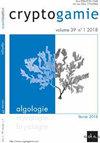burliganella gen. 11 .(硅藻门,硅藻门):基于Fragilaria siolii Hustedt类型材料的中缝还原的另一个案例
IF 1.5
4区 生物学
Q3 MARINE & FRESHWATER BIOLOGY
引用次数: 6
摘要
摘要根据Hustedt于50年代初在亚马逊河流域的采集和描述,描述了一个新的单型硅藻属。利用光镜和扫描电镜对burliganella gen. 11进行了描述,其属型为burliganella siolii (Hustedt) comb。11 .,原属Fragilaria Lyngb。诊断的主要特征包括瓣与尖轴略微不对称,胸骨位于腹缘附近(类似于椎体),而内部有狭缝,与螺旋舌骨无关,没有窗状孔(完全没有)。虽然一些特征将该物种与“蚜虫”属Fragilariforma D.M. Williams & Round联系起来,但Burliganiella与Eunotiales有更多的共同特征。例如,在其他种类的类针叶硅藻中缺少针叶,这表明针叶硅藻中的多个谱系已经减少或失去了针叶系统,例如伯利根菌的情况。本文章由计算机程序翻译,如有差异,请以英文原文为准。
Burliganiella gen. nov. (Bacillariophyta, Eunotiales): Another Case of Raphe Reduction Based on the Type Material of Fragilaria siolii Hustedt
Abstract A new monotypic diatoms genus from Brazil is described based on gatherings and descriptions from the Amazon made by Hustedt in the early 50's. Burliganiella gen. nov. is described using light and scanning electron microscope and has as generitype Burliganiella siolii (Hustedt) comb. nov., originally described within Fragilaria Lyngb. The main diagnosed features include valves slightly asymmetrical to the apical axis with a sternum located near the ventral margin (Eunotia-like) while internally having slits that are not associated with a helictoglossa and no rimoportula (which is completely absent). While some characters link the species to the ‘araphid’ genus Fragilariforma D.M. Williams & Round, Burliganiella has more shared characters with the Eunotiales. For instance, the lack of a raphe in other species of eunotioid diatoms, suggests multiple lineages within the Eunotiales have reduced or lost raphe systems, such as in the case of Burliganiella.
求助全文
通过发布文献求助,成功后即可免费获取论文全文。
去求助
来源期刊

Cryptogamie Algologie
生物-海洋与淡水生物学
CiteScore
2.60
自引率
7.70%
发文量
11
审稿时长
>12 weeks
期刊介绍:
Cryptogamie is a fast-track and peer-reviewed journal of international scope publishing in English only. It accepts original papers and review articles on the taxonomy, biology and ecology of all cryptogams. An issue of Cryptogamie may be devoted to a single topic, under the responsibility of guest editor(s). All articles published in Cryptogamie are compliant with the different nomenclatural codes. A copyright assignment will be signed by the authors before publication.
Cryptogamie, Algologie accepts articles on systematics as well as ecology and evolution of any kind of algae (including Cyanobacteria).
 求助内容:
求助内容: 应助结果提醒方式:
应助结果提醒方式:


